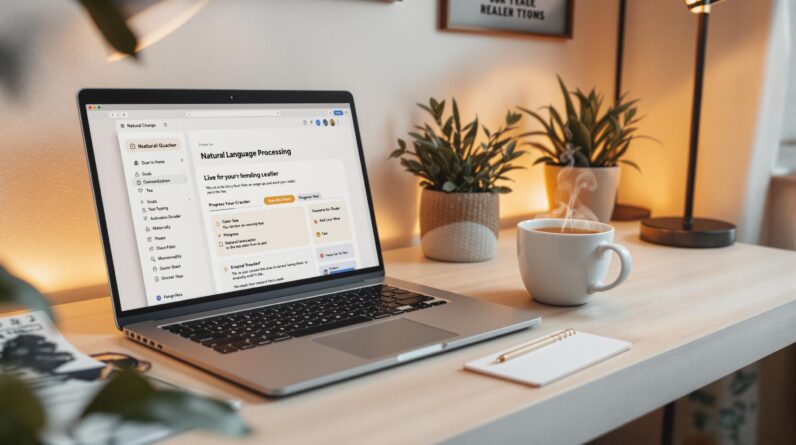
Want to improve your communication and personal growth with NLP? Start by practicing daily. Here’s how:
- Set SMART Goals: Define clear, specific, and measurable objectives (e.g., "Practice active listening for 10 minutes daily for 3 months").
- Create a Quiet Space: Dedicate a distraction-free area for consistent practice.
- Use Habit Stacking: Pair NLP exercises with daily habits (e.g., affirmations with morning coffee).
- Set Reminders: Use alarms, sticky notes, or calendar blocks to stay on track.
- Track Progress: Log your daily practice and reflect on improvements.
Small, consistent steps lead to long-term success. Start with just 10 minutes a day and build from there.
1: Setting Up for NLP Training
Setting NLP Goals
Starting NLP training? Begin by setting SMART goals – these are Specific, Measurable, Achievable, Relevant, and Time-bound. They help you stay focused and track progress. For example: "Practice active listening for 10 minutes daily for 3 months to improve team interactions."
Here’s how you can break down a SMART goal:
| Goal Component | Example |
|---|---|
| Specific | Learn the NLP anchoring technique |
| Measurable | Apply anchoring successfully in 3 situations per week |
| Achievable | Dedicate 15 minutes daily to practice |
| Relevant | Useful for managing workplace stress |
| Time-bound | Become proficient in 6 months |
Clear goals make it easier to stay motivated and measure your success. Once you’ve outlined your objectives, it’s time to set up a space that encourages effective practice.
Creating a Quiet Space
Your environment plays a big role in how well you learn. A consistent, distraction-free space helps you focus and develop better habits.
Here are some tips to create the right setup:
- Find a quiet spot: Choose an area where interruptions are minimal, and silence or remove devices.
- Make it comfortable: Good lighting, a supportive chair, and a tidy setup can make a big difference.
- Use helpful tools: Noise-canceling headphones or calming elements can boost concentration.
Even a small, dedicated corner can work wonders as long as you use it consistently. Sticking to the same location helps condition your brain for focused learning. Research shows it takes about 66 days to form a habit, so consistency during this period is crucial.
Tailor your space to your specific goals. For instance, visualization exercises might need complete silence, while practicing communication patterns may require room for speaking aloud. A well-prepared environment not only supports your learning but also reinforces your commitment to reaching your SMART goals.
2: Establishing Daily NLP Habits
Using Habit Stacking
A simple formula can help you incorporate NLP into your routine: "After/Before [CURRENT HABIT], I will [NEW HABIT]" [4]. This approach makes it easier to remember and stick to your NLP practices.
Here’s a handy example of how to pair NLP practices with your daily habits:
| Current Habit | Stacked NLP Practice |
|---|---|
| Morning coffee | Practice affirmations |
| Pre-lunch break | Do an active listening exercise |
| Evening meditation | Use an NLP anchoring technique |
Start small. Pick one habit to stack, and once it feels natural, add another. For instance, after you’ve mastered pairing NLP goals with meditation, you can add another practice like visualization [2].
Setting Reminders
Habit stacking helps you incorporate NLP into your day, but reminders keep you consistent. Instead of relying on sheer willpower, use simple cues to stay on track.
Here are some ideas for reminders:
- Phone alarms: Set alarms with clear labels like “Morning Anchoring Practice.”
- Sticky notes: Place notes in visible spots to reinforce specific NLP goals.
- Calendar blocks: Schedule dedicated practice times directly into your calendar.
Place these reminders where you’ll naturally notice them – on your desk, bathroom mirror, or even your coffee machine. This way, you’re less likely to miss a session.
Tracking Progress
Once you’re set up with reminders, tracking your progress helps you stay motivated and see how far you’ve come. Regular tracking makes your NLP practice consistent and allows you to identify areas for improvement.
Here’s an example of a simple tracking table you can use in a journal:
| Day | Practice Completed | Duration | Notes |
|---|---|---|---|
| Monday | Anchoring + Affirmations | 15 mins | Felt more focused |
| Tuesday | Active Listening | 10 mins | Improved team dynamics |
| Wednesday | Visualization | 20 mins | Gained better clarity |
Prefer digital tools? Platforms like NLP Yourself offer structured guides to help you stay consistent and track progress with clear milestones. Review your progress weekly – celebrate small achievements and tweak your approach based on what’s working best.
The key here is consistency. Don’t aim for perfection; instead, focus on creating a steady, sustainable practice. Small steps add up over time.
3: Overcoming Challenges
Tackling Procrastination
Feeling stuck or overwhelmed by NLP tasks? You’re not alone – procrastination often stems from taking on too much at once. The key is to simplify. Break your practice into smaller, bite-sized steps. Instead of committing to an hour-long session, start with just 5 minutes focused on one specific technique.
Here’s a simple breakdown to get started:
| Activity | Description |
|---|---|
| 5 minutes: Prep | Quick visualization or breathing exercise |
| 10 minutes: Focus | Practice a single NLP technique (e.g., anchoring) |
| 5 minutes: Reflect | Write down key takeaways and progress |
Time-blocking can also help you stay on track [1]. For example, if you’re working on reframing techniques, schedule 15 minutes right after lunch when your mind is clear.
Struggling with resistance? Try creating a positive anchor. For instance, associate touching your wrist with the sense of accomplishment you feel after a successful session [3]. This small action can help you stay motivated.
Staying Consistent
Sticking to a routine takes more than just willpower – it requires the right support system. Share your NLP goals with friends, coaches, or online communities that can keep you accountable and motivated.
Here’s how to build a rhythm that works:
- Pick one NLP technique to focus on.
- Practice it at the same time every day.
- Celebrate small wins to reinforce your progress.
Miss a day? No problem – just pick it back up the next day without beating yourself up. The goal isn’t perfection; it’s building a habit that sticks over time.
Once you’ve tackled procrastination, staying consistent becomes the next big step. These strategies will help you stay on track and make steady progress in your NLP journey. With the right mindset and resources, you’ll be ready to take on whatever challenges come your way.
sbb-itb-d87b7ee
Related video from YouTube
4: Using Resources for Better Results
Once you’ve built a consistent NLP practice, it’s time to tap into resources that can take your skills further.
NLP Yourself

NLP Yourself is a platform designed to help you deepen your NLP practice. It provides structured training guides that fit seamlessly into your daily habits, making it easier to integrate NLP techniques into everyday life.
Here’s a quick guide to using NLP Yourself effectively:
| Time of Day | Activity | Resource Type |
|---|---|---|
| Morning | Practice quick techniques | Guides |
| Lunch break | Reinforce skills | Articles |
| Evening | Review progress | Reviews |
For example, you could start your day with a guide on anchoring techniques, then practice them during your lunch break. The platform’s focus on workplace communication and personal growth makes it easy to apply what you learn to real-world situations.
While NLP Yourself is a great starting point, exploring additional tools can broaden your understanding and keep your learning dynamic.
Additional Resources
To complement your practice, consider these tried-and-true NLP materials:
Books to Dive Into:
- The Structure of Magic by Richard Bandler and John Grinder – A great choice for morning study sessions.
- NLP: The New Science of Achievement by Steve Andreas and Charles Faulkner – Perfect for evening reflection.
- Influence: The Psychology of Persuasion by Robert Cialdini – Excellent for learning practical applications.
Digital Tools: Platforms like Coursera and Udemy offer detailed NLP courses you can break into manageable segments. The NLP Coach app is another handy resource, providing quick exercises that fit easily into your daily routine.
Pick resources that align with your goals. For example, if you’re focusing on improving communication, prioritize tools offering practical exercises you can apply in conversations.
Keep track of your progress with a journal or digital notes. This helps you see what’s working, refine your approach, and make the most of the resources available to you.
Conclusion: Start Building Your NLP Habits
Building habits around NLP doesn’t have to be complicated. Start small – just 10 minutes of focused daily practice can make a noticeable difference in your communication and personal growth skills [1].
To form effective habits, focus on three key elements:
- Set clear goals: Define specific and measurable objectives for your NLP practice [1].
- Stick to a routine: Practice at the same time each day to build consistency [1][5].
- Track your progress: Keep an eye on your development to stay motivated and make adjustments as needed [1].
As you build these habits, tools like NLP Yourself can offer structured guidance to keep you moving forward. Whether you prefer digital tools or traditional resources, steady progress and patience are key. Incorporating strategies like habit stacking [2] can help reinforce your new routines and set you up for success.
Why not start tomorrow? Practice one NLP technique and see where it takes you. With commitment and the right mindset, you’ll be able to use NLP to improve many areas of your life.
Related posts
- Common NLP Practice Mistakes and How to Avoid Them
- NLP Goal Setting: A Practical Checklist for Success
- How NLP Improves Time Management Skills
- Step-by-Step Guide to NLP Self-Training Success







